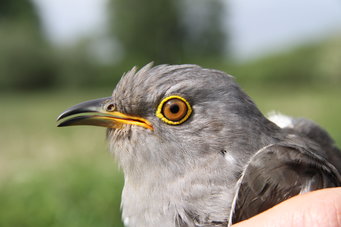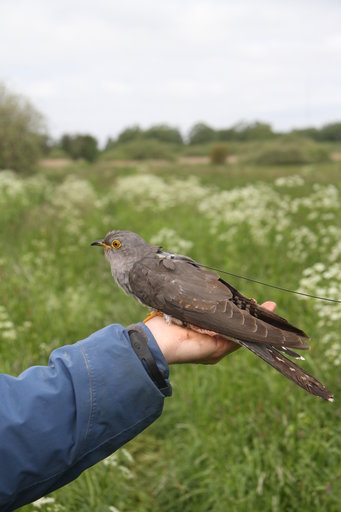Cuckoos stay on course
On their loop migration covering thousands of kilometres to their winter quarters in Central Africa, the birds hardly deviate from their path
With short hectic wing strokes that are hardly raised above the body, the flight of the cuckoo is not the height of elegance. Nevertheless, their wings carry them over 16,000 kilometres a year. Martin Wikelski from the Max Planck Institute for Ornithology in Radolfzell, Germany, together with an international team of scientists, has used satellite data for the first time to follow the cuckoos' migration from their breeding grounds in Denmark and southern Sweden to the wintering sites in Central Africa, and back again. Despite the enormous distances, the routes of the individual birds hardly differ from one another. Flight routes calculated with computer models based entirely on an inborn sense of orientation are far more variable. It seems therefore that cuckoos do not rely solely on an inborn compass-clock-navigation ability, but use additional orientation aids.

Every year, billions of birds leave their breeding and wintering sites behind them and fly around the globe. The different bird species find their destination in different ways. With some species, the young birds can only follow an inborn sense of orientation based on the compass-clock principle, which indicates the correct flight direction as well as the time taken and thus the distance. On their first flight they then learn from older conspecifics to correct for deviations along the route. Experienced animals know conspicuous characteristics of the countryside or may even orientate themselves with the help of the stars. Many species also use the Earth’s magnetic field or can smell where they are at the moment.
Exactly how they orientate themselves and which routes they fly along, is still a mystery for many bird species. For a long time, the ringing of individual birds only provided random samples of the stations along their way. Only in recent years have scientists been able to continuously record and follow in real time the position of individual birds over a longer time span. To this effect, the birds are equipped with battery-powered mini-transmitters which transfer position and motion data to satellites. This allows the researchers to investigate the migratory movements of birds like the cuckoo which do not cross the sky in large flocks and are thus difficult to observe.
Transmitter on board

Together with colleagues from Denmark, Holland, Sweden and the USA, Martin Wikelski of the Max Planck Institute in Radolfzell followed the routes of cuckoos (Cuculus canorus) over the course of a year from Denmark and southern Sweden using the satellite-supported ARGOS tracking system. The five-gramme mini-transmitters on the backs of the birds radioed their position data every two days for ten hours to eight satellites at a height of 850 kilometres. Of the eight birds that were equipped with transmitters in spring 2010, three returned to their breeding grounds the following year, two of them to exactly the place where they were caught.
The Scandinavian cuckoos apparently set off between the end of June and the beginning of August towards their winter quarters. During their journey to Africa of around 7100 kilometres on average, the cuckoos made several stopovers: first they rest for around a month each time in northern Central Europe (Poland) and in Southeast Europe (Hungary, Greece), before they cross the Sahara in the area around the Libyan-Egyptian border. They recover from this leg of the journey for around a month and a half in the eastern Sahel area and then overwinter three months in wooded areas in southwest Central Africa. In February they set off on the 9100 kilometre flight home, and after stopovers in Ghana and the Ivory Coast, West Africa and Italy, they arrive back in their breeding grounds in May – more than ten months after they set off. Not even two months later, they once again start to prepare for their next flight.
The flight of the cuckoo is precisely tailored to local conditions for feeding and breeding. Thus, for example, the birds arrive south of the Sahara exactly when food supplies are plentiful after the rainy season. In addition, they have to synchronise their arrival in the breeding areas with the breeding behaviour of their host species: the further north they breed, the later the breeding season of the potential foster-parents of their chicks. Consequently, they must arrive later in the northern breeding areas. Thus cuckoos from different populations, such as from Great Britain, fly along other routes and at other times.
Masters of navigation

On average, every one of the cuckoos lands during its stopover within 460 kilometres – and that after a flight of thousands of kilometres. “A particularly impressive example for the astonishing sense of direction of the cuckoos is the aerial crossing of the Sahara: After over 5000 kilometres of flight, the birds we fitted landed at a distance of 160 kilometres from one another in southern Chad”, says Martin Wikelski.
But how do the cuckoos manage to steer so precisely towards their targets? After all, every bird flies on its own and then mostly at night. Moreover, the older birds generally leave the breeding grounds before the young birds. This means that the young birds probably cannot benefit from the experience of the veterans nor orientate themselves with the help of conspicuous features of the countryside.
Instead, they presumably follow an inborn flight program which specifies the direction and the distance for them. However, such a built-in navigation system alone is not sufficient, as calculations on the computer show. The researchers simulated on a computer how the flight routes would look if the birds followed a compass-clock navigation system exclusively, or if they additionally orientated themselves via topographical features. “In the simulations, even with shorter stretches, the stopovers were further apart than those observed in nature. Even when the simulations took into account that deviations from the correct flight route end fatally for young birds at particular barriers such as mountains or large bodies of water, the calculated flight corridors were still broader”, explains Wikelski.
A pure compass-clock navigation system cannot therefore explain the narrow flight corridors of the cuckoos. “Cuckoos apparently take into account additional information from their environment such as winds, odours or structures in the landscape. They do not just follow such indications, but always know beyond this exactly where they are and head directly for intermediate targets - perhaps with the help of the odour of the landscape, which they know from earlier journeys", according to Wikelski.
However, the researchers do not yet know just how the young cuckoos find their way for the first time and how they later stick so precisely to their flight plan. For this, they must catch cuckoos, transport them to new locations without the animals being able to orientate themselves on the way, and release them again. The route taken can then provide clues on the orientation behaviour. In addition, the ICARUS research program, planned for 2015 on the International Space Station, should enable the tracking of more and smaller birds – and that with a thousand times greater precision.
In any case, the narrow flight corridors of the cuckoos are of great importance to the survival of the animals. Destruction of the habitats in the narrowly circumscribed intermediate stops, flight obstacles or intensive hunting can be a threat to the existence of entire populations. The protection of these corridors is similarly important to the preservation of the resting and breeding grounds of such prominent species as coastal birds, geese and cranes.
HR


